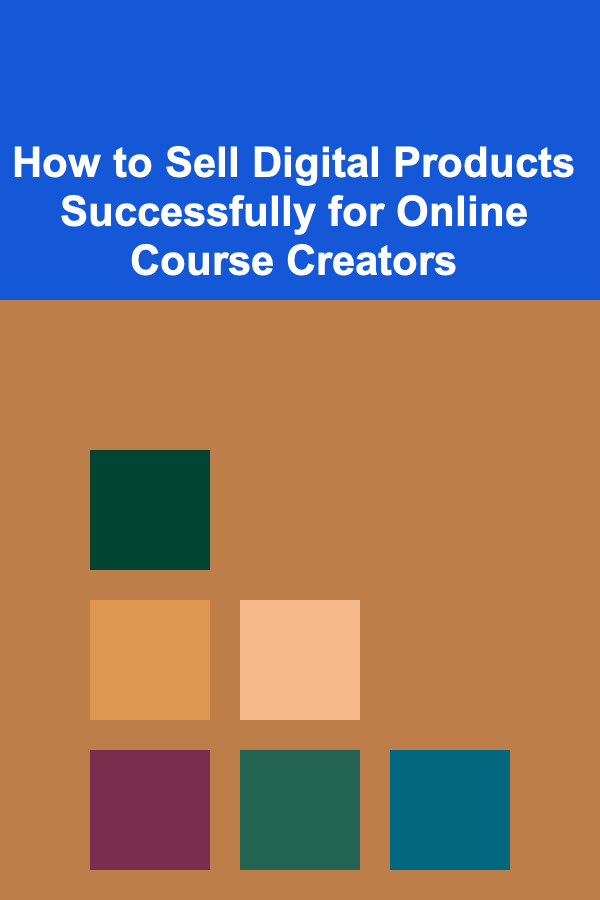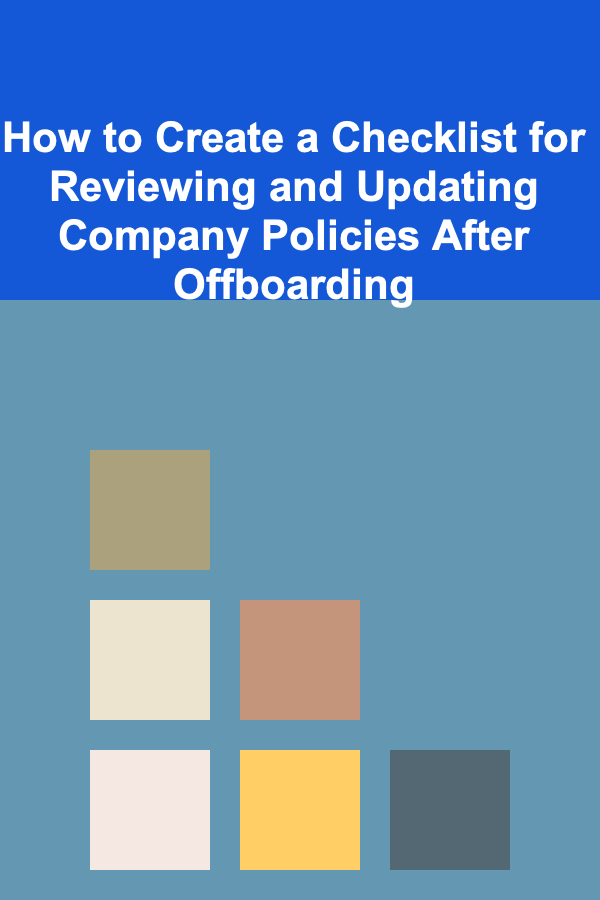
How to Sell Digital Products Successfully for Online Course Creators
ebook include PDF & Audio bundle (Micro Guide)
$12.99$6.99
Limited Time Offer! Order within the next:

Selling digital products is one of the most lucrative and scalable ways to build a business, especially for online course creators. The digital product space offers an incredible opportunity for entrepreneurs to reach a global audience, establish passive income streams, and establish authority in their niche. However, selling digital products is not as simple as just creating a course and putting it online. Success requires strategic planning, marketing, and execution. In this actionable guide, we will explore the steps you need to take to successfully sell digital products as an online course creator.
Understand Your Target Audience
Before you start creating and selling your digital product, you need to understand your target audience deeply. This step is foundational to every action that follows. Here's how to do it effectively:
Define Your Ideal Customer
Start by creating a detailed buyer persona. This should include:
- Demographics: Age, gender, location, occupation, education level.
- Psychographics: Interests, values, goals, and challenges.
- Behavioral traits: Where they spend time online, what type of content they consume, how they prefer to learn, and what kind of solutions they seek.
Identify Pain Points and Needs
What problems or challenges is your audience trying to solve? Successful digital products cater to specific pain points, offering tangible solutions that make life easier for the customer. Conduct surveys, read industry forums, or interview potential customers to understand their exact needs.
Validate Your Idea
Before creating your course or digital product, validate your ideas with your audience. This can be done through polls, social media feedback, or pre-selling your product. If you don't have an audience yet, consider starting a small online community, such as a Facebook group or email list, to engage directly with potential customers.
Create a High-Value Digital Product
Creating a successful digital product requires focusing on delivering value. Here's how you can build a product that resonates with your target audience:
Choose the Right Format for Your Product
There are several types of digital products that online course creators can sell:
- Online Courses: Video tutorials, workshops, and lessons that teach your audience a specific skill.
- E-books: Informational books or guides that offer valuable insights on a specific topic.
- Printables: Templates, worksheets, and planners that help your audience stay organized or accomplish specific tasks.
- Membership Sites: Offer ongoing, exclusive content to your audience through a subscription model.
The format of your digital product should align with how your target audience prefers to consume content. If they prefer visual learning, an online course might be the best option. If they like reading, an e-book or guide may be more suitable.
Ensure High-Quality Content
Your product must provide exceptional value. This means:
- Expertise: Ensure that the content you offer is authoritative and reflects your expertise in the subject.
- Engagement: Make the content engaging and interactive. Use quizzes, exercises, and discussions to keep learners involved.
- Simplicity: While depth is essential, simplicity is key. Avoid overwhelming your audience with unnecessary information. Focus on delivering the most actionable and concise insights.
Professional Production
If you're creating an online course, invest in good-quality video and audio equipment. A poorly produced course can quickly turn off potential customers. If creating an e-book or printable, ensure the design is clean and professional. Consistency in branding is also crucial---your digital products should feel like part of a cohesive brand.
Build an Effective Sales Funnel
A sales funnel is a key part of your strategy to turn visitors into buyers. Here's how to build a funnel that converts:
Step 1: Create Awareness
The first step in your sales funnel is to create awareness of your digital product. This is where your marketing strategy comes into play. Use content marketing, social media, and SEO to drive traffic to your website or landing page. Some effective strategies include:
- Content Marketing: Write blog posts, record videos, or host podcasts that solve problems for your audience and subtly promote your product.
- Social Media: Share tips, success stories, and testimonials on platforms like Instagram, YouTube, LinkedIn, or Facebook. Engaging with your audience on social media is key to building a community around your product.
- Collaborations and Guest Appearances: Partner with other creators in your niche for joint webinars, interviews, or promotions to expand your reach.
Step 2: Capture Leads
Once you've attracted traffic, the next step is to capture leads (potential customers) by offering something of value in exchange for their contact details. You can offer:
- Free Downloads: Offer free resources such as a sample lesson, a mini-course, or an e-book.
- Lead Magnets: Create something valuable that addresses your audience's pain points, like a checklist, template, or guide.
Build a well-designed landing page with clear calls to action (CTAs) that encourage visitors to download your free resource in exchange for their email address.
Step 3: Nurture Leads
Once you have a potential customer's email address, it's time to nurture them. Provide regular, valuable content via email, such as:
- Educational Content: Share useful insights and tips relevant to your digital product.
- Testimonials and Case Studies: Showcase real-life success stories from people who have benefited from your course or product.
- Special Offers: Send occasional discounts or bonuses to entice potential customers to make the purchase.
The goal is to build trust and credibility so that when you make your offer, they are more likely to buy.
Step 4: Make the Offer
Now that you've built trust, it's time to make your offer. Ensure that your sales page clearly communicates the value of your digital product. Some key elements to include:
- Clear Product Description: What is the product? How will it solve the customer's problem?
- Pricing and Payment Options: Make sure your pricing is clear, and offer payment options if possible.
- Bonuses and Limited-Time Offers: Create urgency by adding bonuses or limited-time discounts.
- Testimonials: Social proof is vital for convincing potential customers to take the plunge. Feature testimonials from past students or users of your product.
Step 5: Upsell and Cross-Sell
After your customer makes a purchase, consider offering related products to increase your average order value. For example:
- Offer additional, advanced courses.
- Provide one-on-one coaching sessions.
- Suggest additional resources, such as e-books or printables, that complement the course.
Optimize Your Pricing Strategy
Pricing your digital products correctly is crucial to maximizing sales. Here are a few strategies to consider:
Understand Your Market
Research your competitors and determine what similar products are priced at. Your pricing should reflect the value you provide but also be competitive within your market.
Offer Multiple Pricing Tiers
Consider offering tiered pricing for your digital products. For example:
- Basic Package: Includes the core course or product.
- Premium Package: Includes additional resources, one-on-one coaching, or a private community.
This gives customers options and can increase overall sales by catering to different budgets.
Use Scarcity and Urgency
Limited-time offers and scarcity (e.g., only a certain number of spots available) can encourage customers to make a purchasing decision faster. However, make sure that your scarcity tactics are genuine and not misleading.
Market and Promote Your Digital Products
Selling digital products successfully relies heavily on your ability to market and promote them effectively. Here are some ways to boost your marketing efforts:
Email Marketing
Email marketing is one of the most effective ways to promote your digital products. Build a solid email list, segment it according to customer behavior and interests, and create personalized campaigns. Use automation tools to send follow-up emails, reminders, and promotional offers.
Social Media Marketing
Leverage social media platforms to create buzz around your digital products. Use storytelling and authentic engagement to connect with your audience. Run Facebook or Instagram ads to target your ideal customers.
Influencer and Affiliate Marketing
Partnering with influencers or affiliate marketers who have access to your target audience can increase your product's exposure. Provide them with unique affiliate links and offer them a commission for each sale they generate.
Conclusion
Selling digital products successfully as an online course creator requires more than just creating high-quality content. It's about building a deep connection with your target audience, crafting a compelling sales funnel, strategically pricing your products, and employing smart marketing tactics. When done right, digital products can provide a sustainable, scalable source of income, giving you the freedom to focus on creating and growing your brand.
By following the actionable steps outlined in this guide, you'll be well on your way to building a successful business selling digital products that not only help your customers but also allow you to achieve your entrepreneurial goals.

How to Create a Checklist for Reviewing and Updating Company Policies After Offboarding
Read More
How to Create a Drawer for Entertaining Essentials
Read More
How to Install a Home Security System Yourself
Read More
How to Make Money Online as an Analyst: 10 Actionable Ideas
Read More
How to Organize a Fun and Relaxed Brunch Party at Home
Read More
How to Sell Vintage Toys at a Local Flea Market: An Actionable Guide
Read MoreOther Products

How to Create a Checklist for Reviewing and Updating Company Policies After Offboarding
Read More
How to Create a Drawer for Entertaining Essentials
Read More
How to Install a Home Security System Yourself
Read More
How to Make Money Online as an Analyst: 10 Actionable Ideas
Read More
How to Organize a Fun and Relaxed Brunch Party at Home
Read More